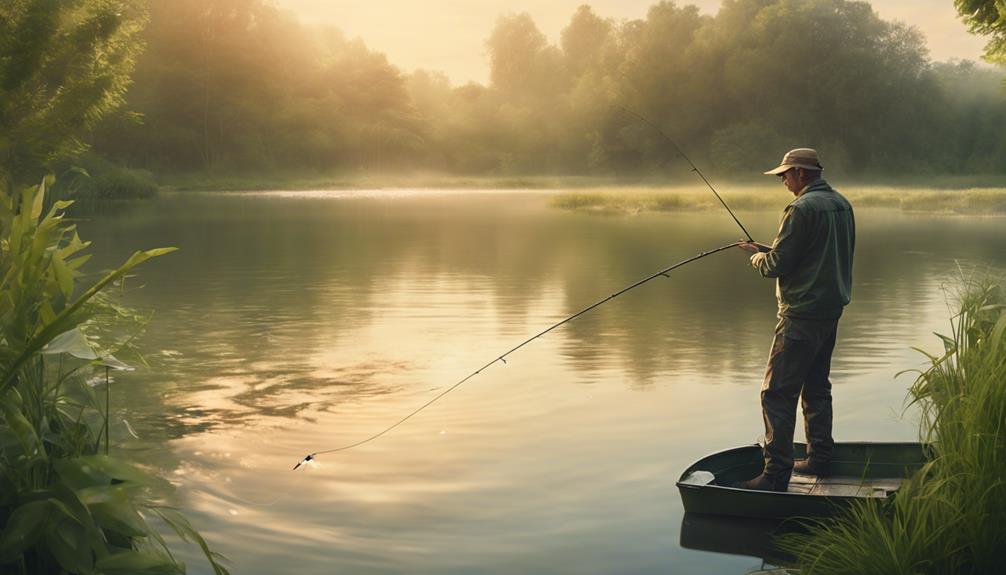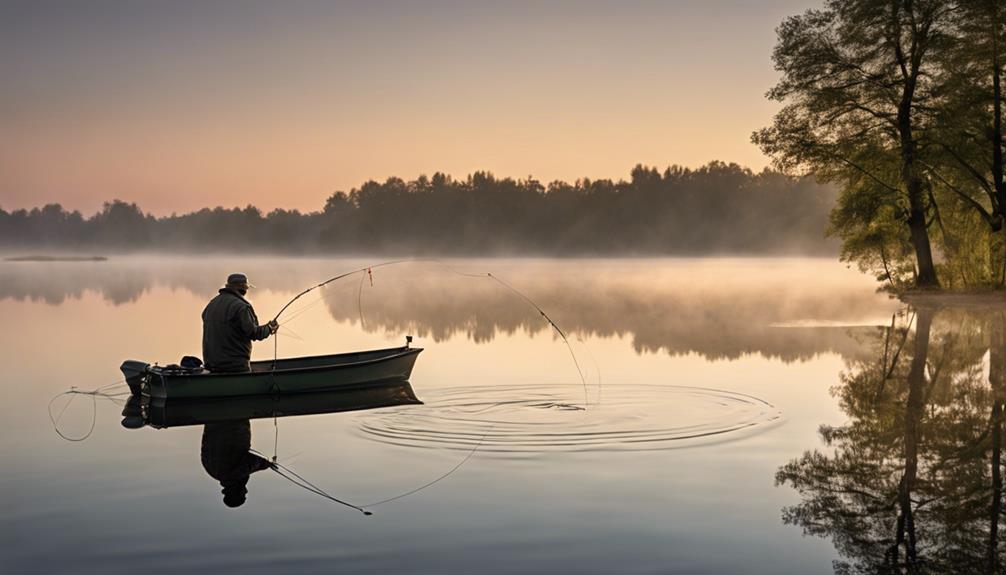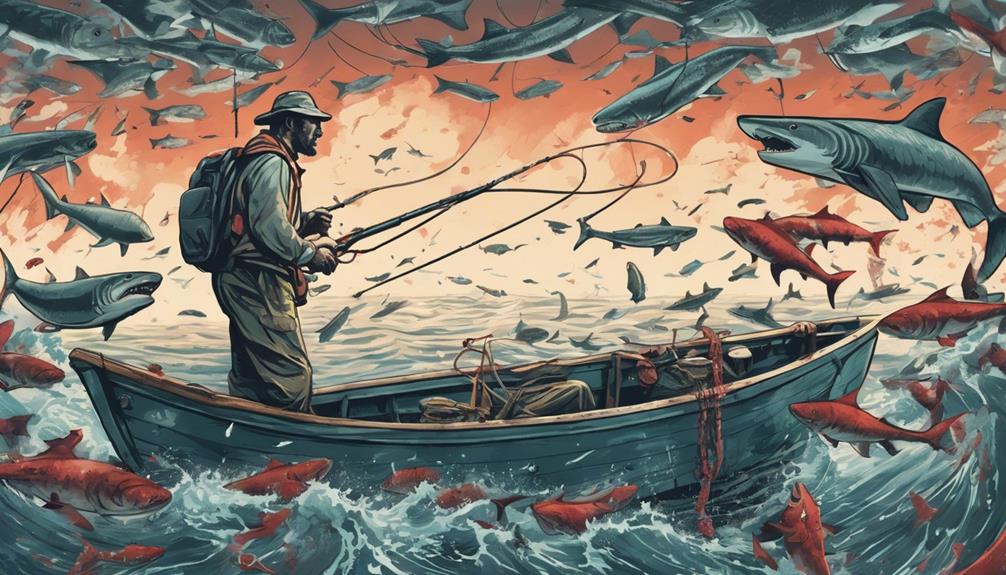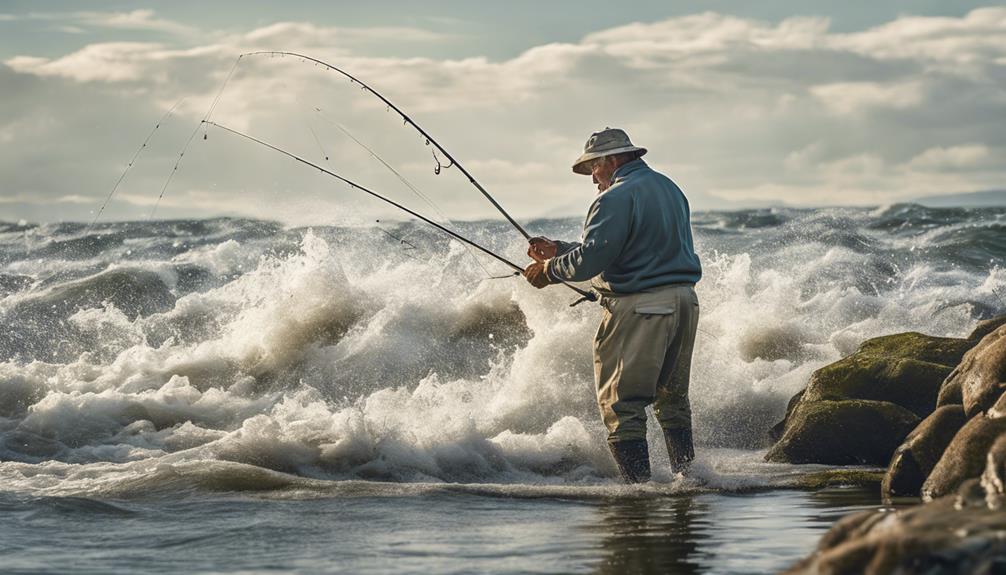Imagine your fishing rod as a conductor's baton, orchestrating a symphony of precision and skill in the tranquil waters. Each cast, each movement, a step towards mastering the art of carp fishing.
As you delve into the intricacies of PVA Bags, Zig Rig presentations, and Spodding techniques, a world of possibilities opens up before you.
Stay tuned to uncover the secrets that will elevate your carp fishing game to new heights, ensuring each outing is not just a day by the water but a captivating dance with these elusive underwater giants.
Utilizing PVA Bags for Precision
If you want to enhance your carp fishing precision, consider using PVA bags to streamline your approach. PVA bags offer several advantages when used correctly. These bags help to present your bait effectively by creating a concentrated area of attraction around your hookbait. This can be particularly useful when fishing in weedy or snaggy areas where you want to ensure your bait is delivered precisely where you want it. Additionally, PVA bags can help to protect your bait from nuisance fish, giving carp a better chance of finding and taking your offering.
However, there are some drawbacks to using PVA bags. One common issue is that if not tied correctly, the bag can burst prematurely, scattering your bait and potentially spooking the fish. It's essential to practice tying PVA bags securely to avoid this problem. Another drawback is that in some situations, particularly when fishing at range, the added weight of the PVA bag can affect casting accuracy. Experimenting with different rig configurations can help mitigate this issue.
When using PVA bags, you can try different rig setups to see what works best for your fishing style. Some anglers prefer to use a simple hair rig inside the PVA bag, while others opt for more intricate setups like the multi-rig. The key is to test different configurations and observe how they impact your fishing success.
Perfecting Zig Rig Presentation
To enhance your carp fishing skills further, focus on perfecting the presentation of your Zig Rig. When setting up your Zig Rig, consider the depth adjustment carefully. Carp often cruise at different levels in the water, so experimenting with various depths can help you find where they're feeding. By adjusting the depth of your Zig Rig accordingly, you increase your chances of attracting carp.
In addition to depth adjustment, your baiting strategy plays a crucial role in Zig Rig presentation. As carp primarily feed by sight, the visibility of your bait is essential. In waters with low clarity, opt for brightly colored or buoyant baits to attract carp effectively. Similarly, consider the visibility of your line. In clear waters, a stealthy approach with a fluorocarbon leader can make a significant difference in enticing wary carp to take the bait.
Mastering the presentation of your Zig Rig involves a balance between depth adjustment, baiting strategy, and visibility factors. By paying attention to these details and making subtle adjustments based on water clarity and line visibility, you can increase your chances of landing more carp. Experimentation and observation are key to refining your Zig Rig presentation and ultimately achieving success in carp fishing.
Mastering Spodding for Baiting
Master Spodding techniques for precise baiting to enhance your carp fishing success. When it comes to spodding accuracy and baiting efficiency, having a solid baiting strategy is key. One crucial aspect of mastering spodding is controlling the distance at which you're casting your bait. By perfecting your spodding technique, you can ensure that your bait is distributed accurately and efficiently across your fishing spot.
To improve your spodding accuracy, practice your casting technique to hit the desired spot consistently. Adjust your spod rod's setup to achieve the right distance control, enabling you to bait effectively within your fishing area. By mastering the art of spodding, you can avoid bait wastage and ensure that your bait is concentrated where you want the carp to feed.
Develop a baiting strategy that complements your spodding technique. Consider the type of bait you're using, the quantity needed, and how often you should spod to keep the fish interested. By combining precision in spodding accuracy with an efficient baiting strategy, you can increase your chances of attracting carp to your fishing spot and ultimately improve your catch rates. Mastering spodding for baiting is a skill that can significantly enhance your overall carp fishing success.
Enhancing Hook Bait Attraction
Enhance the attraction of your hook bait by incorporating proven scent and flavor combinations to entice carp effectively. Scent enhancement plays a crucial role in drawing carp towards your hook bait. Utilize potent flavors like strawberry, garlic, or fish oil to create a trail of enticing scents in the water, guiding carp towards your bait. Visual stimulation is equally important. Opt for brightly colored baits that stand out in the water, increasing the chances of catching the carp's attention.
Consider bait positioning to maximize your chances of success. Place your hook bait strategically where carp are known to feed. By understanding carp feeding behavior, you can position your bait in areas where they're likely to be present, increasing the likelihood of a successful catch. Experiment with different depths and distances from the bank to find the optimal position for your hook bait.
Remember that carp have a keen sense of smell and are attracted to specific scents and flavors. By enhancing your hook bait with irresistible combinations and strategically positioning it in areas where carp frequent, you can significantly improve your chances of a successful carp fishing session.
Fine-Tuning Marker Float Use
As you refine your carp fishing skills, optimizing the use of marker floats can significantly elevate your angling success. When fine-tuning your marker float technique, two crucial elements to focus on are depth accuracy and line visibility.
Here are some advanced tips to help you maximize the effectiveness of your marker floats:
- Marker Float Setup: To ensure precise depth accuracy, adjust your marker float so that it sits just right in the water, allowing you to accurately measure the depth of your swim. Make sure your line is set up correctly and that the float is visible from a distance.
- Marker Elastic: Consider using different colored elastics on your marker float. This can help enhance line visibility, especially in varying light conditions. Bright colors like orange or yellow can make it easier to spot your float from a distance.
- Float Positioning: Experiment with different float positioning techniques to achieve the best depth accuracy. By adjusting the distance between the float and the lead, you can fine-tune your setup for different fishing scenarios.
- Regular Checking: Continuously monitor your marker float during your fishing session. By regularly checking the position of your float and the visibility of your line, you can make quick adjustments to ensure optimal performance.
Maximizing Bite Alarm Setup
To optimize your carp fishing experience, ensure you maximize the effectiveness of your bite alarm setup. Proper bite indication and rod positioning are crucial for a successful catch. Begin by setting up your alarms with the right sensitivity. Adjust it to be responsive enough to detect subtle movements but not too sensitive that it gets triggered by the wind or small disturbances. Position your rods so that they're aligned with the direction of the carp's movement to increase the chances of a solid hookset.
Additionally, familiarize yourself with the different sound variations of your alarm. Some alarms offer customizable tones or volumes. Experiment with these settings to find what works best for you. A loud, continuous sound may startle cautious carp, while a series of shorter beeps could be more effective in signaling a bite without scaring the fish away.
Remember to regularly check your alarms throughout your fishing session. Ensure they're free from any debris that could obstruct their function. By maximizing your bite alarm setup in terms of sensitivity and sound variations, you can significantly improve your chances of detecting and successfully hooking carp.
Adapting to Changing Weather Conditions

Make sure to adjust your fishing approach to adapt effectively to changing weather conditions. Carp fishing can be greatly influenced by the weather, so being prepared with the right strategies for different conditions is crucial for success. Here are some key tips to help you adapt to varying weather scenarios:
- Rainy Day Strategies:
When the rain is pouring down, try using brightly colored baits to increase visibility in the murky water. Carp tend to feed more actively during rain showers, so take advantage of this by casting your bait closer to the margins where the fish are likely to be foraging.
- Windy Weather Tactics:
In windy conditions, carp may move to calmer areas of the water. Use heavier leads to ensure your bait stays in place and consider fishing closer to features like islands or overhanging trees that can provide shelter for the fish. Additionally, adjusting your casting angles to work with the wind rather than against it can help improve your accuracy and presentation.
Exploring Underwater Topography
Exploring underwater topography can reveal hidden feeding spots and migration routes for carp, enhancing your chances of a successful fishing session. By utilizing underwater mapping techniques, you can gain valuable insights into the layout of the lake or riverbed. Understanding the depth perception of the water body you're fishing in is crucial for locating where carp are likely to congregate.
Carry a depth finder or a fish finder to help you map out the underwater terrain. These tools can show you variations in depth, underwater structures, and potential hotspots where carp may be hiding. Look for features like drop-offs, submerged vegetation, rocky areas, or underwater channels. Carp are known to navigate along these underwater contours, so identifying these areas can significantly improve your fishing success.
Once you have identified potential spots using underwater mapping, consider using a marker float to precisely mark these locations. This will help you accurately position your baits and maximize your chances of attracting carp. Remember to adjust your rigs accordingly based on the depth and features of the underwater topography you have discovered.
Exploring underwater topography through underwater mapping and understanding depth perception is a valuable technique that can give you a competitive edge in carp fishing. Take the time to study the underwater landscape, and you may just uncover the key to a rewarding fishing experience.
Frequently Asked Questions
How Can I Effectively Camouflage My Fishing Line to Avoid Spooking Carp in Clear Water Conditions?
To effectively camouflage your fishing line and avoid spooking carp in clear water conditions, focus on line concealment and understand carp behavior. Opt for clear or green monofilament lines that blend in with the environment. Use fluorocarbon leaders or sinking lines to make them less visible underwater.
Employ stealth tactics like casting gently and avoiding sudden movements to prevent startling the carp. Stay low and keep a low profile to increase your chances of success.
What Are Some Common Mistakes Anglers Make When Using PVA Bags for Precision Fishing?
When using PVA bags for precision fishing, some common mistakes anglers make include overstuffing the bag, using baits that are too big, or not sealing the bag properly.
For successful PVA bagging tips, ensure you measure the right amount of bait, use smaller baits for clear water fishing, and seal the bag securely to prevent it from opening prematurely.
These adjustments can help improve your carp fishing technique and increase your chances of a successful catch.
Is It Possible to Overdo the Use of Spodding When Baiting for Carp, and How Can I Avoid This?
When baiting for carp, it's possible to overdo spodding, affecting their feeding behavior. Proper spodding techniques involve spacing out your casts and using the right amount of bait.
Carp are sensitive to line visibility, so keeping your presentation subtle is key. By avoiding excessive spodding, you can prevent alarming the carp and ensure they continue to feed confidently.
Understanding carp behavior and adjusting your approach accordingly will increase your chances of a successful fishing session.
Are There Any Alternative Hook Bait Options That Are Particularly Effective for Attracting Carp?
When fishing for carp, try using different hook bait options to attract them. Boilie variations and pop up rigs work great for enticing carp.
Experiment with particle mixes and method feeders to see what carp are interested in. By testing these alternative options, you may find what works best for your fishing style and the carp in your area.
Keep exploring and adapting to improve your success in catching carp.
What Are Some Indicators to Look for on a Marker Float That Suggest Potential Hotspots for Carp Activity?
When looking at a marker float, keep an eye out for signs like bubbles, weed beds, or changes in water depth that could point to potential carp hotspots.
Utilize marker float techniques to pinpoint these areas. Be cautious of clear water camouflage and take steps to prevent your line from spooking the carp.
These hotspot indicators can help you focus your efforts where the carp are likely to be hanging out.
Conclusion
Now that you've learned these advanced techniques for successful carp fishing, you'll be well-equipped to tackle any challenge that comes your way on the water.
By utilizing PVA bags, perfecting your zig rig presentation, mastering spodding, and fine-tuning your setup, you'll be sure to increase your chances of landing that prized catch.
Remember to adapt to changing weather conditions and explore underwater topography for even greater success.
Happy fishing!



